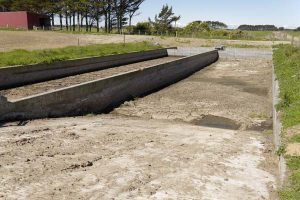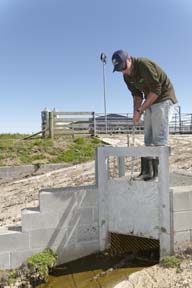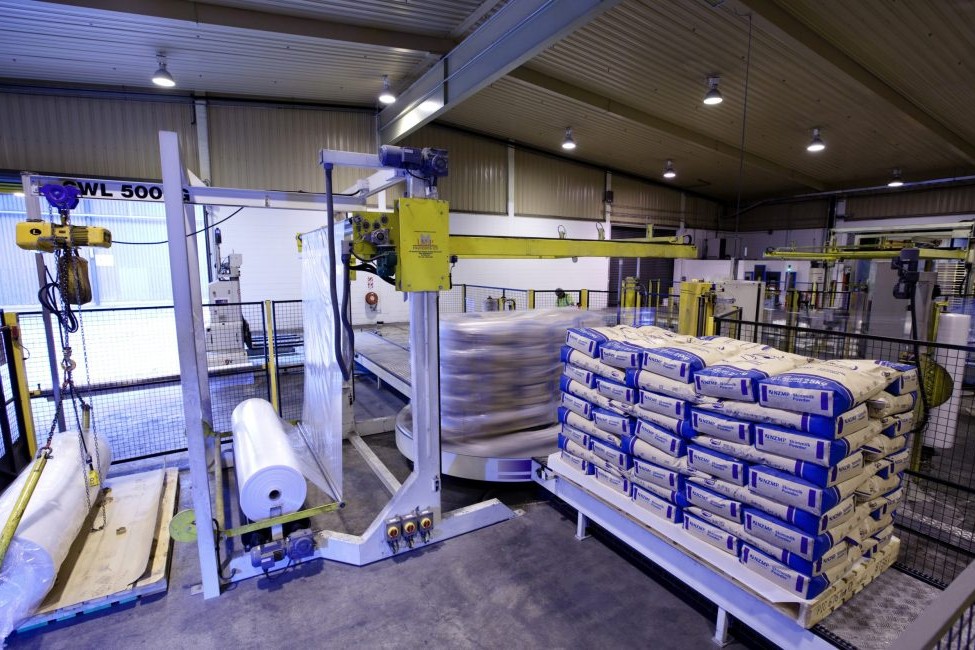Merging two, tired South Taranaki dairy blocks into a modern operation was a challenge to be relished for Vanessa and Jacques Le Prou. Jackie Harrigan reports.
Future-proofing their farm and dairy business was foremost in the minds of Vanessa and Jacques Le Prou when developing their rundown Pihama dairy farm.

Five years ago the Le Prous bought two adjacent coastal Taranaki dairy blocks featuring old infrastructure and 60-year-old run-out dairy pastures in partnership with Jacques’ parents. Putting the two blocks together to form a 140-hectare unit has been a massive project for the young couple who relished the challenge but say it was like doing a whole-farm dairy conversion.
“In some ways we were able to start with a clean slate and plan it to be just as we wanted it so we took the opportunity to look 10-15 years out and see where the industry was heading.”
The forward-thinking couple developed a farm with new central dairy shed, reformed races, fences, water system and a new, upgraded effluent treatment system, all built to handle an increased stocking rate.
The new dairy shed is a 60-bale rotary placed in the centre of the farm, with a new bridge bringing walking times down to 20 minutes from more than an hour from the back of the farm. The shed has minimal automation, other than cup removers, but along with the yard and feedpad is capable of handling 600 cows should the couple wish to expand the operation to that level.
Both Jacques and Vanessa worked in the dairy industry after Lincoln University B Ag Comm degrees (where Blenheim-born Vanessa met Opunake-born Jacques), guaranteeing many robust discussions about policies, stocking rates and feeding levels, among other things. Vanessa spent two years as a DairyNZ consulting officer on the coast before working for Pioneer while Jacques was in the fertiliser industry before going dairy farming and sharemilking for family concerns.
‘Ideally we want a system that works well on any payout – so we are targeting 450 cows producing 100% of their bodyweight, around 450kg MS/cow, while keeping costs under control.’
While they planned for a 600-cow operation, a halving of the $8-00/kg milksolids (MS) payout when they were part way through building the new shed and developing the farm made them rethink the resilience of their business and how dependent on bought-in feed the operation would be at that stocking level.
The farm is operating a System 2, importing around 10% of feed, but a stocking rate of 4.2 cows/ha at 600 cows would need much higher levels of inputs, Vanessa says.
“Ideally we want a system that works well on any payout – so we are targeting 450 cows producing 100% of their bodyweight, around 450kg MS/cow, while keeping costs under control.”
Taking into account the ‘peak cow’ rhetoric of the election and looking forward in the industry has made the couple rethink their targets for 600 cows and decide to aim for higher per-head production, using crops to fill feed gap s and drive production.
Cropping focus
Part of future-proofing the business involves the aim of moving away from palm kernel and growing their own crops – so Vanessa and Jacques are experimenting with different crops and forage mixes, and using the cropping programme to renew old pastures.
“We don’t want to be susceptible to feed prices on the open market so we are experimenting with crops and insulating ourselves from falling payouts so we are not forced into pulling out feed from the system,” Vanessa says.
A quarter of the farm is cropped each year and from that 12.5% of the total area is sown into new permanent pastures.
“Half the farm was very old pastures and the other half around 20 years old, so the plan is to finish renewing the older pastures in three or four years and then start on the younger ones.”
Just two years into the cropping programme they are still experimenting but enjoying the diverse pastures resulting from the mix of crops and forages.
“We have decided we don’t want a solely ryegrass sward – we are planning for a mixed sward with ryegrass, clover, chicory and plantain.”
Coming out of the maize half of the area goes into the permanent mixed forage and half will be further cropped with an annual ryegrass, chicory, plantain or in the past rape.
The first maize crop was sown into plantain clover mix which grew really well through the winter – a very good result, Jacques says.
“We have undersown grass into the chicory for the first time this autumn, so we have the grass growing in those paddocks in the winter when the chicory is dormant,” Jacques says.
With the success of the undersowing the couple have increased the chicory area from a small calf paddock to nine hectares.
The coastal strip can get summer-dry, so turnips, chicory and rape are grown to keep the cows fully fed – although last summer turned out to be more wet than dry so the rape wasn’t really needed, Jacques says.
“We need to have enough crop on-hand to provide 4kg drymatter (DM)/day for each cow between December and March/April in a dry year to supplement any pasture and maize we have on hand.”
Maize is grown on both the milking platform and the runoff to ensure enough is ensiled to fill any feed gaps to the tune of one tonne/cow along with the turnips and rape. A further 300-400kg/cow is bought in – a mixture of palm kernel and dried distiller grains, but the couple plan to phase out the palm kernel and filling the gap with other forages in the future.
Effluent system wishlist
Low labour requirement: many systems they investigated took lots of tidying up and shifting of solids and liquids. Jacques and team member Jason Fieldsend keep the whole operation to two fulltime employees with Vanessa’s help with calves and accounts.
Low mechanical intervention: Vanessa and Jacques say neither of them are mechanically minded – they wanted to minimise mechanical and electrical parts to decrease any breakdowns and intervention required.
Low water: low water requirement ticks boxes for both cost and usage. The water scheme the farm belongs to inevitably has increasing costs over time.
New effluent system
Feeding any supplement on the feedpad minimises wastage and the Le Prous built silage bunkers adjacent to the pad to cut down on time and distance travelled. They also oriented them to capture seepage or runoff in their new effluent system, along with runoff from the dairyshed wash, and green floodwash from the yard.
In designing their new effluent system they also took a future-thinking approach, designing it for what might happen rather than what is happening now, Jacques says.
They looked around Taranaki and sought advice from the Taranaki Regional Council (TRC), but didn’t see anything that fitted their criteria of low labour requirement, low mechanical parts/intervention and low water requirement.

TRC has rules about moving to land application away from the old three-pond system and the Le Prous were aware that the draft annual plan was under review.
“Here in Taranaki we are lucky with our geography and forgiving soils, but we can see a time where the nutrient and effluent rules will become tougher – we wanted to be ready for that,” Vanessa says.
“We didn’t see any system in Taranaki that we wanted to replicate. People seemed to be forever scraping and moving muck and then shifting it again – it seemed very time-consuming and time-wasting – we wanted to do it once and do it right.”
They visited the Waikato Effluent Expo and through getting in touch with the Fonterra sustainability adviser were able visit Waikato farms and research their systems.
Meeting Davieth Verheij, a specialist effluent engineer from AgFirst Waikato Engineering was a turning point and through his association with Coastal Agri Services in Opunake they were able to get him to visit their site and to discuss all the options.
“He was awesome – he had been through it all and knew the ins and outs of all the systems so we settled on two weeping walls which we had seen in the Waikato,” Vanessa says.
The Le Prous say it was definitely worth while getting an engineer involved, as theirs was the first installation of double weeping walls in Taranaki.

Splitting the weeping wall in two with a solid barrier in between and a selector gate is an innovation that allows one side to dry out ready for scraping while the other is still in use and the size of the pond is minimised.
The angle of the slope of the feeder trough to the wall is counter-intuitive, but it works really well, Jacques says.
“The slope is away from the wall, and so the solids are not pressed up against the weeping wall slots, causing blockages.
“Rather just like you pour sand into a cup of water, the water rises up and the solids sink to the bottom and the water is drained out over the lip.”
The liquids from the green recycled floodwash and the clean hosedown water seep through the weeping wall and are pumped through a small pump to the lined effluent pond next door. No agitator is needed in the pond as only liquids are pumped in there before they are pumped out into the greenwash tank or irrigated on to 60ha of the farm.
While the farm is consented to spread on to 15ha the Le Prous irrigate 60ha with a travelling irrigator and because there is little solid content the cows don’t mind eating the resultant grass.
Pumping costs are low due to the liquidity of the material needing only a small pump, which fills the floodwash tank and also irrigates the land. The water is recycled many times through the 25,000 litre floodwash tank into the yard, and occasionally down the feedpad through a similar system before it goes on to the pasture. The pond size is also smaller because of the greenwater being recycled.
The solids sit in the concrete trough and build up for six months then the effluent is diverted to the other channel and the first one dries to a low drymatter through drainage and evaporation. Once a year the Le Prous pay a contractor $1600 to scrape out the dried solids and apply them to a maize paddock before cultivation.
Deciding to line the clay pond with a synthetic liner was another future-proofing decision.
The couple say the whole system has worked really well, is very easy to run and maintain and gives peace of mind that they can happily go away and leave someone else to run it.
“The labour requirement is really low, it’s not complicated, you literally push a button and it works.
“It’s like a big composting system. We can push the calf bedding down the chute too.”
The Le Prous rear 100 heifer calves each season, trying to build their numbers and move on some cows of “mixed ability and mature years” they inherited with half of the farm a going concern and the other half of the cows bought cheaper in the downturn.
“There were a few age groups missing and the cows were of very mixed production, so we are breeding up and retaining more heifers – it will be another three or four years until we hit out straps with a good mixed age herd,” Jacques says.
While the effluent system cost $60,000 more than a standard system without the weeping walls and green floodwash, Vanessa and Jacques say a payback period of six to eight years and the longevity of the simple system made it worthwhile.
“The system is very simple and robust, it should last many, many years.”
Next on the development list is the automation in the shed. Jacques says.
“The payout was too low to afford any automation other than automatic cup removers so one person could milk, next we would like to get some technology that weighs and monitors the cows and their health – that would be great for early detection of lameness and mastitis and help detect cycling.”
Green cost savings
The saving from the weeping wall and greenwash systems are substantial with Vanessa and Jacques banking an extra $9000 each year.
Water: $3000 each year is saved on water purchased through the water scheme.
Fertiliser: A $3000/year saving on the fertiliser forgone on the crop/maize area where the dried solids are spread. Recent nutrient testing of the weeping wall solids showed 160kgN/ha applied over 16ha, a saving of $1600, plus savings from P, K, S and Ca nutrients. These savings will grow in the future as maintenance fertiliser will not be needed, Vanessa says.
Power: savings of $3000 each year from not having to stir the effluent in the pond, the smaller pump required to pump liquid only and less hosing with the gravity-fed floodwash and a scraper on the backing gate.
Added benefits are the savings from low servicing and no breakdowns.
Farm facts:
Milking platform: 140ha effective
Runoff: 14ha
Cows: 400 Kiwicross cows
Production: 160,000kg MS/ha (1142kg MS/ha)
Target: 450 cows producing 100% of liveweight (202,500kg MS)
Cropping mix
17 ha maize
12ha plantain
9ha chicory
4ha turnips
3ha rape
7ha maize on runoff





